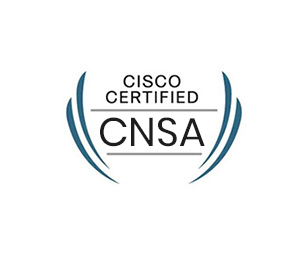CNSA Course is a set of strategies for managing the processes, tools and policies necessary to prevent, detect, document and counter threats to digital and non-digital information. Infosec responsibilities include establishing a set of business processes that will protect information assets regardless of how the information is formatted or whether it is in transit, is being processed or is at rest in storage.
Duration: 5 Months
Outcome: it provides you with a better understanding of important current security principles. It also demonstrates continuous improvement on your part.
That means it:
- Information Security certifications cover a range of disciplines and emerging security trends, from cloud computing to secure software coding to overall security management..
- The Information Security certification shows your ability to build on your knowledge and learn about current security topics.
- Certification validates that a security professional has a specific set of skills and capabilities. For human resources managers, certification provides a screening mechanism to match potential candidates with the skills, knowledge, and experience an organization is looking for in a security professional.
- It helps you get in the door when pursuing a job or promotion and helps you advance toward a rewarding career in security and IT system administration.
- In contrast, security-conscious employees help reduce vulnerabilities. Many organizations value certified employees recognizing that they help them mitigate expensive security threats.
- Certification can help you remain competitive and employable at any stage of your career.
- Certification shows your ability to build on your knowledge and learn about current security topics.
- A certification is a good way to increase your value and stand out in a competitive industry. The value you gain from the certification gives you an edge when weighed against others who have not validated their knowledge. It helps you get in the door when pursuing a job or promotion and helps you advance toward a rewarding career in security and IT system administration.
Audience: Those who are looking for the future in the field Information security, Cyber Security, Ethical Hacking.
Prerequisite: Not specific but those who are pursuing Engineering, BCA, MCA, B.Sc. IT, M.Sc., B.Com Computer, and who are planning to build their career in the field of System, Security, and Network Administration.
Contents:
There are 3 modules that will be covered are:
- Red Hat Certified Engineer (including advance topic)
- Cisco Certified Network Associate(CCNA)
- LA Certified Information Security Expert
CCNA Contents:
- Basic Networking
- Introduction to Wide Area Networks
- Internetwork Operating System (IOS)
- IP Routing (Static & Dynamic)
- LAN Switching
- IPv4 & IPv6
- STP,PVSTP,RSTP
- Virtual Private Network –VPN
- Redundancy Protocols
- Network Monitoring Tools
- NAT & PAT
- Cisco Express Forwarding
- Network Device Security
- WAN Technologies
- Troubleshooting
- LA Certified Information Security Expert Content:
Infrastructure Hacking:
- Digital Footprint & Information Gathering
- Network scanning
- Target Enumeration
- Cryptography & Steganography
- Password Cracking
- OS Login Bypass
- Malware Illustration
- Vulnerability Assessment Automation
- Introduction to Metasploit
- Hacking Database
- Exploiting Windows OS by Metasploit
- Exploiting Linux OS by Metasploit
- Reverse Engineering
- Network Sniffing
- ARP & DNS Poisoning
- Wireless Hacking [WEP+WPA1/WPA2]
- DOS & DDOS Attacks
- Social Engineering
- Introduction to Bash Scripting
- Report Generation
Web Application Hacking
- Understanding Architecture of Web Application and Database
- Understanding HTTP Protocol & Issue with SSL/TLS
- Understanding HTTP Methods
- Understanding Content Security Policy & HTP Headers
- Identifying the attack surface policy [Information Gathering – Nikto]
- Hacking Using Google
- OWASP TOP 10
- Introduction to Vulnerable Web Applications
- Vulnerability Scanning Using Owasp Zap
- SQL Injection
- Cross-Site Scripting
- Cross-Site Request Forgery
- XXE Attacks
- OS Code Injection
- Local/Remote File Inclusion
- Cryptographic Weakness
- Insecure File Uploads
- Introduction to WAF
- Evading WAF
- Report Generation
Copyright ©2018 ITE . All right reserved . Developed by Hackerkernel

